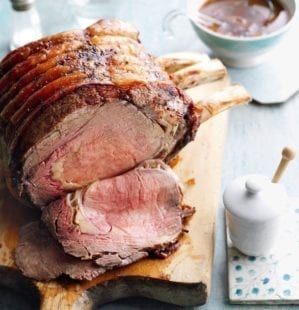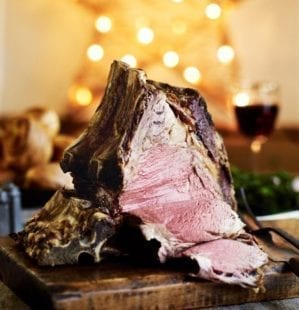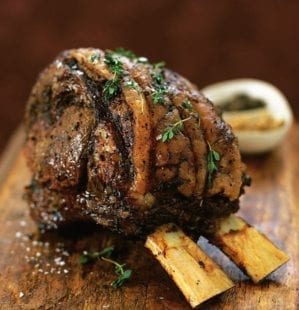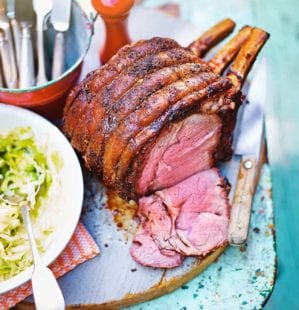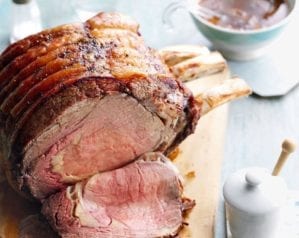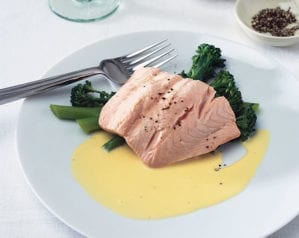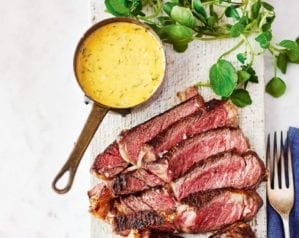
Roast rib of beef with beef dripping chips and stilton hollandaise
- Published: 14 Jan 16
- Updated: 18 Mar 24
You can’t beat proper beef dripping chips and these ones, cooked in the dry aged fat of the rib of beef is packed with flavour. Pared with stilton hollandaise and you’ve got an incredibly decadent Sunday roast.
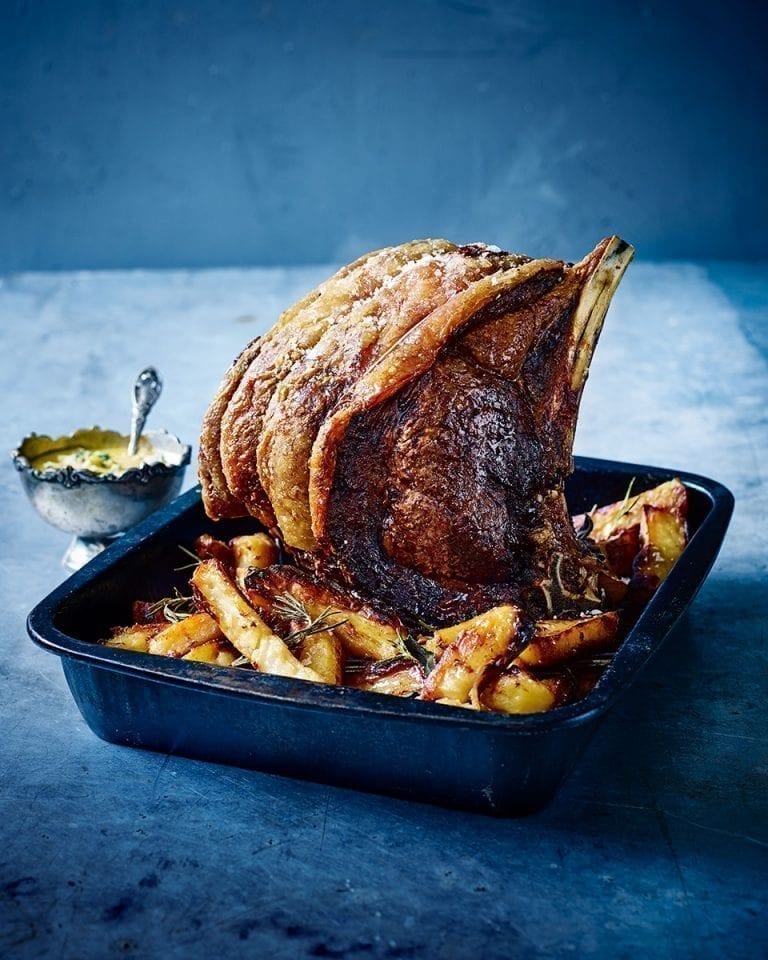
Lighten up your Sunday lunch for summer with our recipe for roast beef with slow-roast tomatoes and lentil salad.
Ingredients
- 3 bone forerib of dry-aged British grass-fed beef (around 4-5kg) – see Know-how
- 2.5kg floury or baking potatoes, sliced into very fat chips
- 1-2 tbsp sunflower or olive oil, plus extra for rubbing
- Handful woody herbs – we used thyme, sage and rosemary
For the stilton hollandaise
- 180ml white wine vinegar
- 2 bay leaves
- 3 shallots, finely sliced
- 4 mace blades
- 1 tsp peppercorns
- 250g unsalted butter
- 4 free-range egg yolks
- 120g stilton, crumbled
Method
- Take the beef out of the 2-3 hours before cooking its chill. Put the potatoes bowl filled with heavily salted water and soak for 1 hour (this removes excess starch and helps season them all the way through).
- Heat the oven to 220°C/200°C fan/ gas 7. Rub the oil all over the beef and season. Put directly on an oven rack with your largest roasting tin beneath (see tip) and roast for 30 minutes.
- After 30 minutes, reduce the heat to 170°C/150°C fan/gas 31⁄2. Drain the potatoes, pat dry with a clean tea towel and toss with 1-2 tbsp oil in a mixing bowl until lightly coated. Remove the roasting tin from the oven, toss the potatoes into it with the herbs, then put back under the beef. Turn the potatoes occasionally so they cook evenly. The beef fat/ juices will drip onto the potatoes – don’t worry if some break up.
- Roast the joint for 23⁄4-3 hours more until it reads 55°C on a probe thermometer pushed into the centre for medium-rare or 60°C for medium (see Know-how). Check the meat after 2 hours – after it reaches 40°C it will rise more quickly, so keep checking. Once the beef is done, take out of the oven and leave to rest for 30 minutes. If the potatoes need help to crisp up, turn up the oven.
- For the hollandaise, first make a vinegar reduction. Put the vinegar, bay, shallots, mace and peppercorns in a medium pan with 180ml water, bring to a simmer, then bubble until reduced to 4 tbsp. Melt the butter in a small pan, then transfer to a jug. Strain the vinegar reduction through a sieve (discard the flavourings) and put 3 tbsp in a medium heatproof bowl (reserve the remaining tbsp) set over a pan of barely simmering water (don’t let the bowl touch the water). Add the egg yolks with a pinch of salt, then whisk for a minute or so until it starts to froth (use a balloon whisk). Slowly trickle the melted butter into the bowl, whisking constantly to thicken the mixture. If it doesn’t thicken after a minute or so, stop adding butter and whisk until it does, then slowly add more butter. If the mixture looks greasy at any point, whisk in a splash of cold water.
- When all the butter has been added, the sauce should be smooth and thick enough to coat the back of a spoon. Taste and add the reserved reduction if needed – it should be on the sharp side to counteract the cheese. Stir in the cheese, taste and season as needed, then cover the sauce with a piece of cling film directly touching the surface. Turn the heat off under the pan but leave the sauce on top. Lift up the cling film and stir every so often. It will keep warm for 15-20 minutes.
- Once the potatoes are golden and crisp and the beef has rested, carve the beef and serve with the chips, hollandaise for dipping and a big green salad on the side. If you like, stir the beef resting juices into the hollandaise for extra flavour.
- Recipe from November 2015 Issue
Nutrition
- Calories
- 893kcals
- Fat
- 45.3g (23.5g saturated)
- Protein
- 79.4g
- Carbohydrates
- 39.7g (2.4g sugars)
- Fibre
- 4.4g
- Salt
- 0.7g
delicious. tips
The chips need space to crisp up, so use the biggest roasting tin you have. If they’re still crowded, roast them in 2 tins, one beneath the other, and swap every 30 minutes.
Make the vinegar reduction for the hollandaise (step 5) up to a week ahead, then strain and keep covered in the fridge.
A rib of beef isn’t cheap, so we recommend you use a digital probe thermometer to make sure it’s cooked to the right temperature. The temperature at the centre of the joint will carry on rising for a while after you take the beef out of the oven, so do stick to our guidelines here.
We think dry-aged beef is best medium-rare – the centre is pink and juicy, but the meat fibres are clearly set (see In Our Test Kitchen This Month). If you’re not using dry-aged beef, the cooking times might be a little bit longer, as the meat will contain more water.
Buy ingredients online
Rate & review
Rate
Reviews
Subscribe to our magazine
Food stories, skills and tested recipes, straight to your door... Enjoy 5 issues for just £5 with our special introductory offer.
Subscribe
Unleash your inner chef
Looking for inspiration? Receive the latest recipes with our newsletter

